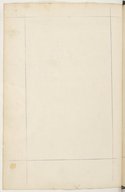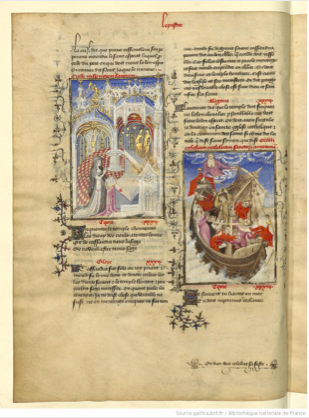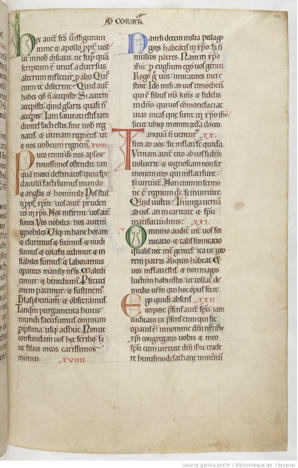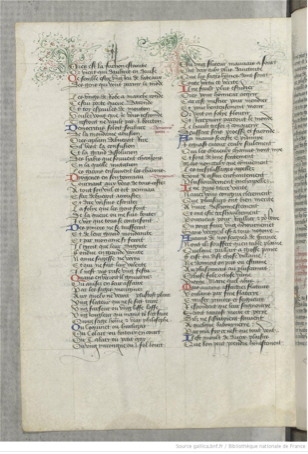In order to further the possibilities of arriving at an automated generalization or "average" perception of an entire manuscript, we might take another approach (See my initial approaches in The Manuscript Average, Part 1). Instead of superposing all the pages together to formulate an average or to find the darkest pixels in the stack, let us consider the spectrum of colors available on each page.
For example, if we digitally extract the number of colors from individual pages of manuscript Fr. 5617 from the Bibliothèque Nationale de France and reduce them to a range of 256 colors and arrange those colors on a spectrum, we can easily discern differences between pages with varying visual content.

fol. 14v
This spectrum represents the presence of reds, golds, greens and blues on this page. The original full-size image actually contains 185,942 unique colors. Most of these colors provide seamless gradient transitions across smooth surfaces. A reduction algorithm generates an average of all these gradients: a spectrum of 256 colors that correspond most closely to the full color set. Such a significant reduction has surprisingly small effect on the overall spectrum of the image and the 256 colors constitute a faithful representation of the original color contents.


fol. 37v - Arranged by hue

fol. 37v - Ordered from darkest to lightest

fol. 37v - Ordered from least saturated to most saturated
The 256 colors of folio 37v are organized in the top spectrum by color with the purest red on the far left, followed by oranges, yellows, greens, blues and purples, in that order, if present. Alternatively, the same colors can be arranged from darkest to lightest colors or from least to most saturated (from gray to "colorful"). For the purposes of this project, the relationship of hues provides a more useful visualization. Throughout this essay, the top spectrum (arrangement by color) will be used exclusively. For example, on this folio, the importance of the various shades of red are especially evident in relation to the overall range of colors.

fol. 56v
Our eye detects and the spectrum confirms that blue and gold dominate this page.

fol. 71r
Even a small patch of blue around a block capital can leave a significant imprint.

fol. 80r
The ink from a text-filled page registers as dark bands in the left third of the spectrum. Gray can appear as low-saturated colors in any area of the spectrum, but medieval ink is usually more brown. Varieties of brown appear as dark shades throughout the orange and yellow parts of the spectrum.

fol. 5r
A page with no text offers a baseline for comparison.

fol. 5v
Here is another page with no text. We would expect this spectrum to be be nearly identical to the preceding example, but the spectrum is based on the entire digital image, not just the folio represented in it. In this case the crop allows two dark patches of the binding in the right-hand corners to influence the spectrum results. Notice that in all these examples, the plain white border around the manuscript also figures in the results.
The Spectrum Array
If we now take a spectrum from each page of the entire manuscript and stack them all one below another, we arrive at a visual array of data that provides another kind of summary of the entire volume. In order to reduce the space required for this visualization, each spectrum is condensed to a height of one pixel. For closer examination, each row can be expanded by dragging the cursor over the array.
As we can clearly surmise, manuscript Fr. 5617 has numerous colorful illustrations in the first portion of the manuscript, but the remainder of the pages are filled with text and a fairly regular appearance of block capitals.
Notes généalogiques sur la maison d'Autriche et journal des voyages de Charles-Quint, fait par Jean de Vandenesse
(Drag cursor over the array to enlarge a single spectrum.)
In the examples below, we can compare the features in the spectrum arrays of different manuscripts. In addition to giving a sense for color distribution within the pages of each manuscript, these visualizations also make the relative length of each manuscript readily apparent (manuscripts with fewer pages have a shorter array).
Les Très Riches Heures du Duc de Berry
The highly saturated colors in this celebrated manuscript are well represented in this spectrum stack. We immediately notice the horizontal breaks in the colorful array that represent unadorned pages and sections. Upon closer inspection of the first group of folios, we discern the alternation between the famous full-page illuminations and the plain text of the calendar on facing pages. This is especially visible in the green range (just right of center on the spectrum). A sample page from this manuscript may be viewed providing a single representative example along with its own corresponding spectrum.
Sample page
L'Epistre Othea la deesse, par CHRISTINE DE PISAN
The traces of the lightest colors in both BNF Fr 606 and BNF NAL 2694 (below) come from the border of the uncropped images, although in BNF Fr 606, they could also represent the frequent appearance of gold leaf, the luster of which is captured in these photographs.
Sample page
Johannes Cassianus, De institutis coenobiorum et de octo principalium vitiorum remediis
The color scheme of BNF NAL 2694 distinguishes itself from the previous examples with the significant presence of green in the numerous ornate capitals that adorn the entire volume.
Sample page
Histoires du grant Alexandre de Macedone, par QUINTE-CURCE
FR 22547 reveals fewer saturated colors. The vertical band of blue results from the numerous block capitals and colored line fillers that appear on almost every page. Less frequent are the many large illuminations which appear here as longer horizontal bars of blue and green at fairly regular intervals. Two separate vertical bands of brown (brown-toward-orange and brown-toward-yellow) consistently represent a variation which may distinguish the brown ink of the text from the gold leaf, which these photographs often render as reflecting dark.
Sample page
La Bible de Louis d'Orléans, volume 5
In La Bible de Louis d'Orléans, there are no illuminations or gold leaf. Multi-color canon tables appear toward the beginning of the manuscript. Capital letters appear on nearly every page in blue, red, green and light brown. On a few pages, there are very large, monochromatic capitals, which cause significant shifts in the spectrum for those pages. It not evident what might cause the three distinct vertical bands of dark brown.
Sample page
La Quête du Saint Graal et la Mort d'Arthus, de GAUTIER MAP
There are numerous illuminations and large block capitals in the first half of this Arthurian manuscript. In the second half, the blank spaces that were reserved for more decorations bear faint traces of preliminary sketches or are completely blank. Traces of purple appear in the right of the spectrum array because the pen flourishes on the gold capitals are in purple ink.
Sample page
Le Champion des Dames, par MARTIN LE FRANC
Alternating red and blue capitals appear at the beginning of every eight-line stanza of this poetic text, thus imposing a constant pattern of red and blue throughout the array. There is also clear evidence of the frequent pen flourishes in green ink.
Sample page
Similar to the manuscript averages proposed in Part 1 of this essay, the spectrum array of a given manuscript may not provide concrete data that lead to precise analyses or conclusions. It does provide a visualization that can be generated through a digitally automated process and which can allow for a reliable, if preliminary, study of color distribution and relations within manuscripts. It is important to keep in mind, however, that the photographic conditions (lighting, white balance, page crop, etc.) and the quality of the digital archives used to generate this data can vary considerably not only from one collection to another, but also between manuscripts photographed at the same location. Nevertheless, once trained to observe the minute discrepancies between these charts, one can attain an informed overview of a visual aspect of an entire manuscript all in a single glimpse.





























































































































































































































































































































































































































































































































































































































































































































































































































































































































































































































































































































































































































































































































































































































































































































































































































































































































































































































































































































































































































































































































































































































































































































































































































































































































































































































































































































































































































































































































Leave a Reply